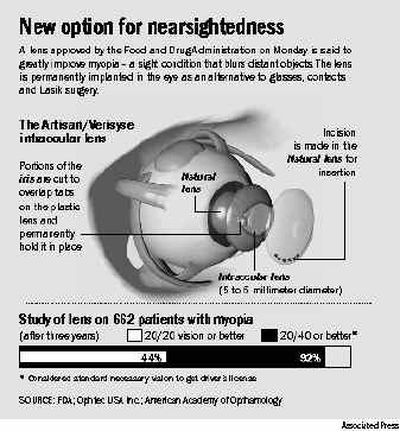Lens implant to sharpen sight

WASHINGTON — There’s a new option for people who suffer from extreme nearsightedness, whose world loses its crisp edge just a few inches from their noses. The first implantable lens for nearsightedness was approved Monday by the Food and Drug Administration.
A surgeon slips the lens through a small incision and implants it in front of the natural lens. Like a photographer swiveling a camera lens into focus, the tiny hard plastic lens works behind the scenes to help the eye create in-focus images.
An estimated 53 percent of Americans use contact lenses or eyeglasses to correct their vision.
The lens implant is designed to provide an alternative to glasses, contact lenses or Lasik surgery for people who have trouble seeing distant objects. Already in use in Europe, the lens is manufactured by Ophtec USA Inc., of Boca Raton, Fla., under the trade name Artisan, which will be distributed by American Medical Optics under the Verisyse brand name.
The implanted lens “provides superior quality of vision, especially for individuals with high myopia,” said Rick McCarley, president and chief executive officer of Ophtec USA.
The lens implant, which will cost $3,000 to $4,000 per eye, currently is targeted at patients who, for various reasons, can’t get Lasik, which costs an average of $1,785 per eye.
McCarley said the lens implant typically is not covered by health insurance because it is an elective procedure. “However,” he said, “we have had some cases … where the patients’ visual acuity, or their level of myopia, was so bad that some insurance companies did work with them because it allowed a person who previously could not work, it allowed them to work.”
“I think it’s huge,” said Robert K. Maloney, an ophthalmology associate professor at the University of California-Los Angeles who has corrected the vision of such stars as Cindy Crawford and Kenny G with Lasik. “It is huge in the same way Lasik was huge a decade ago.”
Maloney, who has performed experimental implant procedures on nearly 100 patients since 1997, said the implantable lens is 50 percent more accurate than Lasik. “And it gives better quality of vision: The vision is crisper, brighter and clearer,” he said.
After three years, 92 percent of 662 patients had 20/40 or better vision, considered standard vision necessary to obtain a driver’s license, and 44 percent had 20/20 or better, the FDA said, citing Ophtec research.
However, the FDA said the lens implant may not eliminate the need for glasses for night driving or other activities performed in low light.
However, some experts warn of the risk of patients developing cataracts or eye-destroying infections.
“Even though that is a very small risk … that is significant,” said Balamurali Ambati, an ophthalmologist and corneal specialist at the Medical College of Georgia. “Anytime the eye is opened, bacteria can get in.”
Nicholas Tarantino, vice president of global clinical research and development for Advanced Medical Optics, said no patients in the U.S. clinical trials developed cataracts.
The FDA is requiring the company to do a follow-up, five-year study of users of the lens to determine any side effects.
One possible concern, FDA said, is the loss of endothelial cells in the corneas of patients who received the implants. These cells form a layer on the undersurface of the cornea and are essential to keeping the cornea clear.